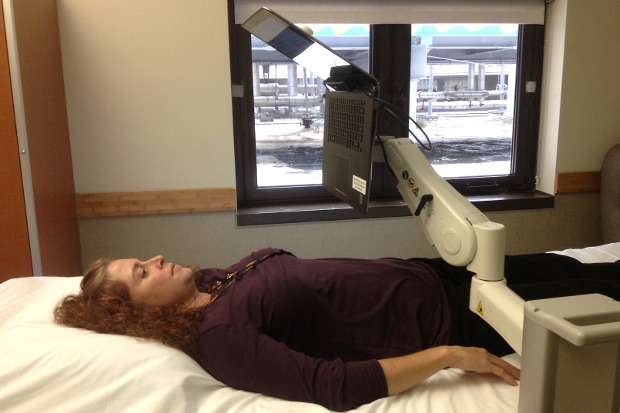Mobile Laptop System Helps ALS Patients and Others with Limited Mobility Communicate by Eye Movement

Shannon Mitchell tests the mobile cart designed by VCU Health medical and IT team. (Photo courtesy of VCU Health)
Researchers created a mobile cart device allowing people to communicate via laptops by eye movement alone. The device was designed with severely disabled tetraplegic patients in mind, but it may also help those with decreased upper extremity and hand function, like that caused by amyotrophic lateral sclerosis (ALS), to more easily work with a computer.
Shannon Mitchell, a recreation therapist in the Department of Physical Medicine and Rehabilitation at Virginia Commonwealth University (VCU) Health, came upon the idea while treating a patient who could not tolerate raising the head of her bed. Mitchell wanted a way of securing both a laptop and the Tobii system, a thin, eye-controlled device that uses infrared technology to perform the same function as a computer’s mouse, above the patient’s bed to allow communication. The therapist took her idea for a portable device that could suspend the laptop-Tobii combo securely and safely to John Watson, an IT technician at VCU. Together with Jerry Langford, a VCU senior systems administrator for the parasurgical unit who served as a liaison with the manufacturer, the team brought the project to life.
“Seeing our idea become a real thing that could help increase the quality of lives, and receiving the support and enthusiasm from everyone involved who helped make this unique and simple solution a reality, was rewarding,” Watson said in a news release. The scientist created a device with the range of motion and stability needed to position the laptop according to the patients’ needs by using the cart base from a patient engagement table, a larger arm and other hinges, and mounting hardware from the manufacturer.
“Our expertise with these patients along with our innovative approach to maximize quality of life has allowed us to utilize and adapt state-of-the-art assistive technology in order to enhance their function. Individuals can recover with variable levels of independence, depending on the degree of completeness of injury and the time after injury, but many are left with permanent impairments,” said William McKinley, MD, VCU director of spinal cord injury medicine in the Department of Physical Medicine and Rehabilitation. “For any of these individuals, our goal is to maximize mobility, self-care and quality of life.”






